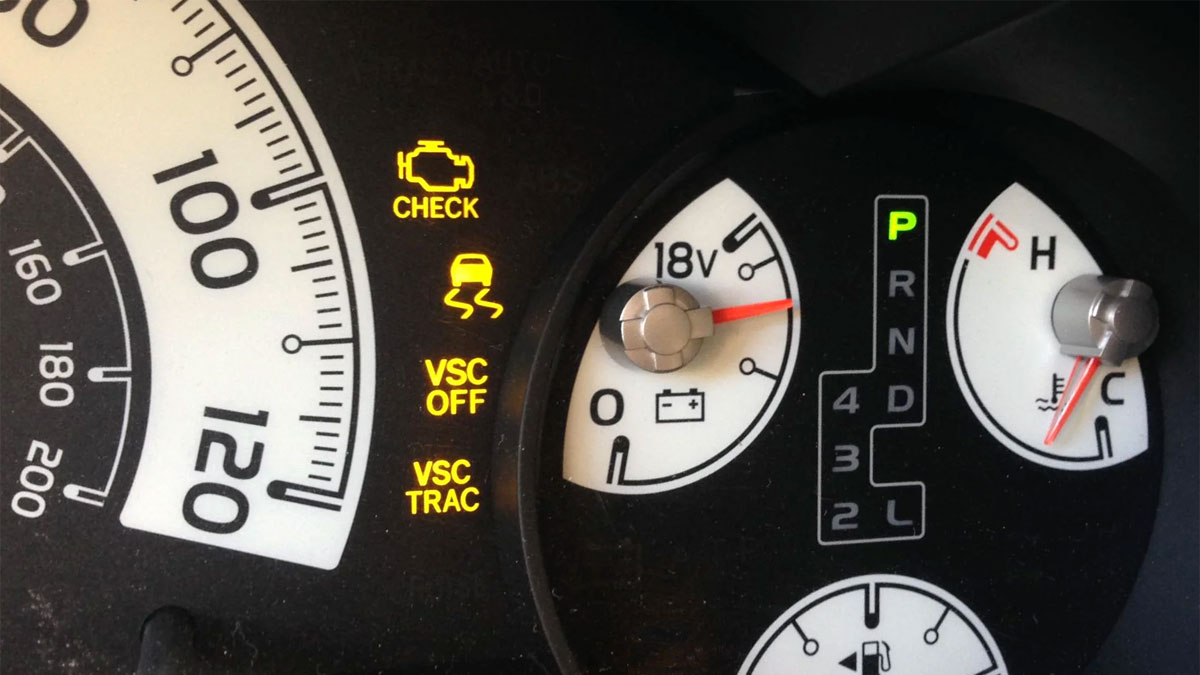Check Engine Light And Vsc Light On Toyota

Ah, the dreaded Christmas tree effect! Your Toyota's dashboard, normally a beacon of reliability, is suddenly lit up like a holiday display. The Check Engine Light (CEL) and the VSC (Vehicle Stability Control) light are on. But what does it all mean, and why does it seem to happen at the most inconvenient times? While a single CEL can indicate a vast range of issues, the simultaneous illumination of both CEL and VSC lights on a Toyota *often* points towards a more specific, though still potentially varied, set of culprits. Let's delve into the nuances across different Toyota models and powertrains.
Common Causes: A Toyota Family Affair
Before we get into model-specific quirks, let's cover the usual suspects that trigger this double-light disco across the Toyota lineup:
- Oxygen Sensors: A faulty O2 sensor can throw off the engine's air-fuel mixture, triggering the CEL. Because this affects engine performance, the VSC system, which relies on accurate engine data, can also be disabled as a safety precaution.
- Mass Airflow (MAF) Sensor: Similar to O2 sensors, a malfunctioning MAF sensor disrupts the air-fuel ratio, leading to CEL and VSC issues.
- Loose Gas Cap: Yes, it's that simple. A loose gas cap can cause a vacuum leak, triggering the CEL and, consequently, the VSC light.
- Misfires: Misfires in one or more cylinders can significantly impact engine performance and trigger both lights. This can be caused by faulty spark plugs, ignition coils, or fuel injectors.
- Catalytic Converter Issues: A failing catalytic converter can trigger the CEL due to emissions issues. Again, this can impact VSC performance.
Model-Specific Considerations: From Corolla to Tundra
While the above are common causes, certain Toyota models exhibit specific tendencies. Let's break it down:
Toyota Corolla/Prius (1.8L 2ZR-FE/FXE Engines):
These fuel-sipping heroes are known for their reliability, but they aren't immune. A common issue on older models is related to the EGR (Exhaust Gas Recirculation) system. Carbon buildup can clog the EGR valve or passages, triggering the CEL and VSC. Hybrid models are particularly sensitive to issues with the hybrid battery system. A drop in battery performance can indirectly trigger both lights.
Spec Table: Corolla/Prius EGR System
| Component | Common Issue | Impact |
|---|---|---|
| EGR Valve | Carbon buildup, sticking | Restricted exhaust recirculation, increased emissions, rough idling |
| EGR Passages | Carbon clogging | Reduced EGR flow, CEL/VSC illumination |
Toyota Camry/RAV4 (2.5L 2AR-FE/FXE Engines):
The ever-popular Camry and RAV4, particularly models from the early to mid-2010s, can suffer from issues with the VVTi (Variable Valve Timing intelligent) system. A faulty VVTi solenoid or oil control valve can cause erratic engine performance and trigger the dreaded duo of lights. Also, the RAV4, being an SUV, is more prone to wheel speed sensor issues, especially if frequently driven off-road or in harsh winter conditions. A faulty wheel speed sensor directly impacts the VSC system and can trigger the CEL indirectly.
VVTi System Pros and Cons:
- Pros: Improved fuel efficiency, increased power output across the RPM range.
- Cons: Complex system with multiple potential failure points, sensitive to oil quality and maintenance.
Toyota Tundra/Tacoma (V6/V8 Engines):
These trucks, built for ruggedness, are more susceptible to issues related to the secondary air injection system, especially in colder climates. The system injects air into the exhaust to help warm up the catalytic converters quickly. If the system malfunctions (e.g., a faulty pump or valve), it can trigger the CEL and VSC. Furthermore, given their propensity for towing and hauling, the Tundra and Tacoma are more likely to experience transmission-related issues, which can also trigger both lights.
Real-World Driving Impressions: Different Engine, Different Feel
Driving a Corolla with a CEL and VSC light might feel like a slight loss of power and fuel efficiency. A Camry might exhibit rough idling and hesitation during acceleration. However, in a Tundra with the same illuminated dashboard, you might experience noticeable shifting problems or a distinct lack of power, especially when towing.
Decoding the Codes: The Key to Diagnosis
No matter the model, the first step is to get the error codes read using an OBD-II scanner. These codes provide valuable clues to the underlying problem. Common codes associated with the CEL and VSC lights include:
- P0171: System Too Lean (Bank 1)
- P0174: System Too Lean (Bank 2)
- P0300: Random Misfire Detected
- P0420: Catalyst System Efficiency Below Threshold (Bank 1)
- C1201: Engine Control System Malfunction
Remember, the error code is just a starting point, not a definitive diagnosis. Proper diagnosis requires a thorough inspection and understanding of the vehicle's systems.
The Fun Part: A Debate for the Ages
So, which is the *most* annoying Toyota model to diagnose when both the CEL and VSC lights come on? Is it the Prius with its complex hybrid system, the Camry with its finicky VVTi, or the Tundra with its potentially failing secondary air injection system? Let the arguments begin! And may your wrenches be ever in your favor!
